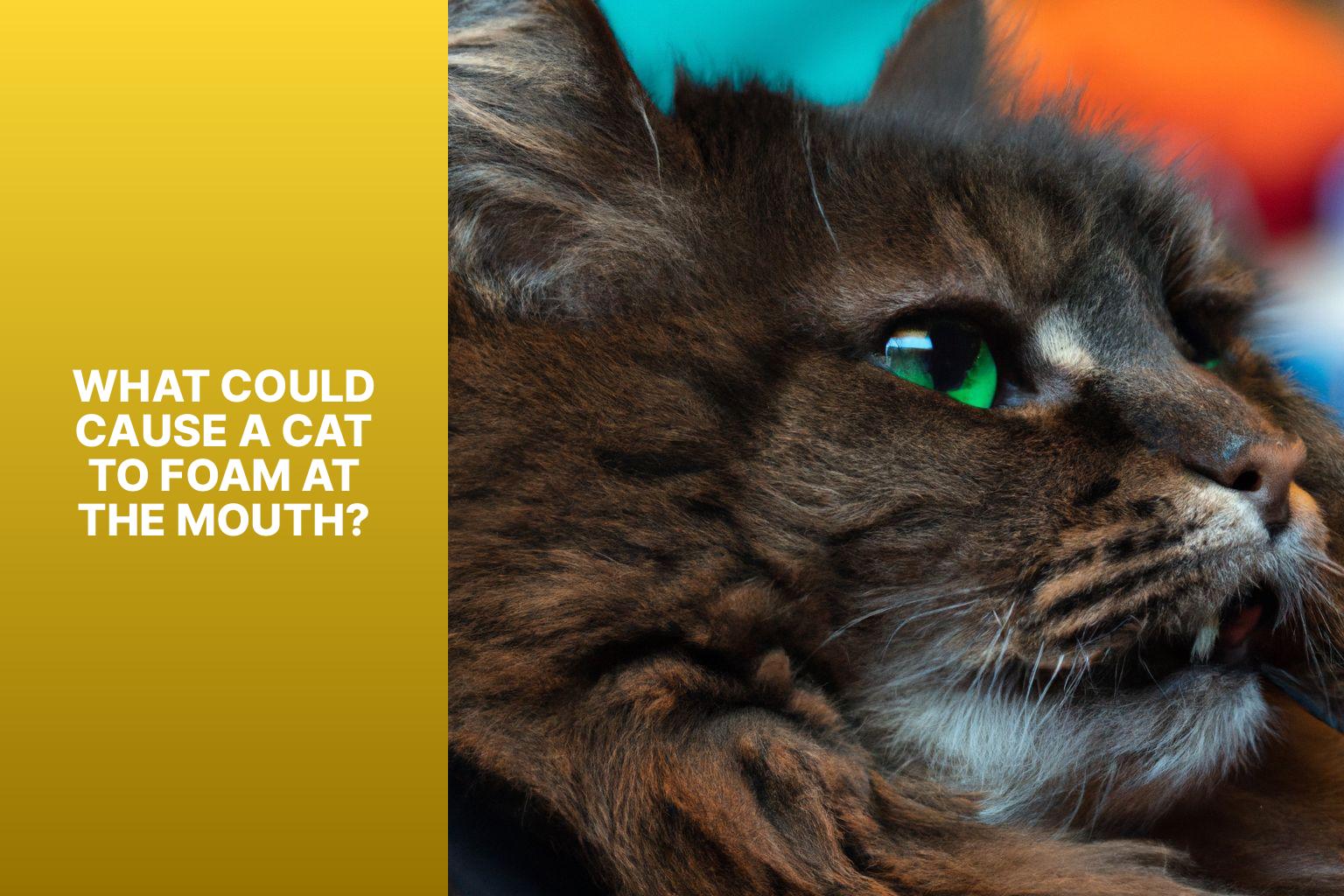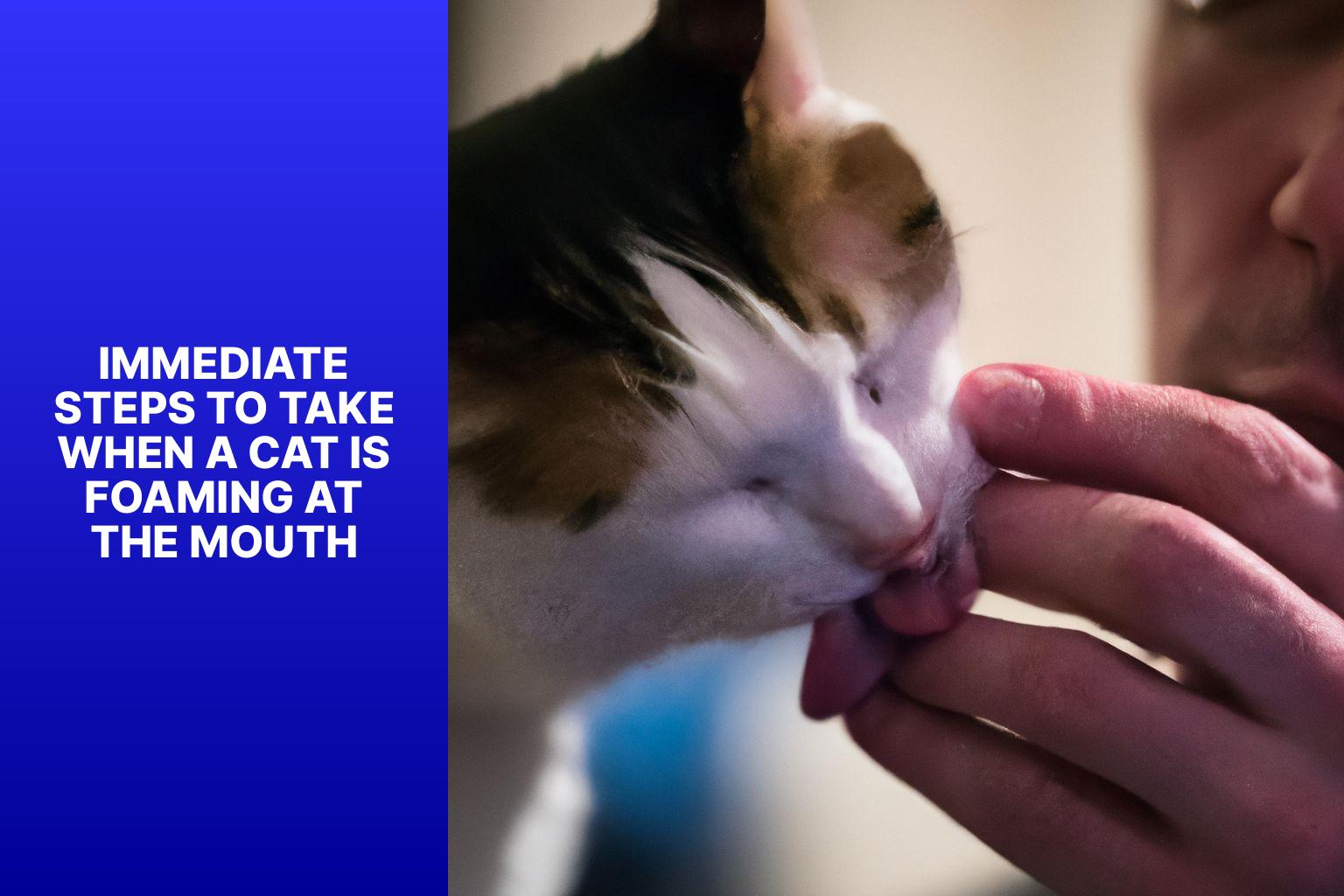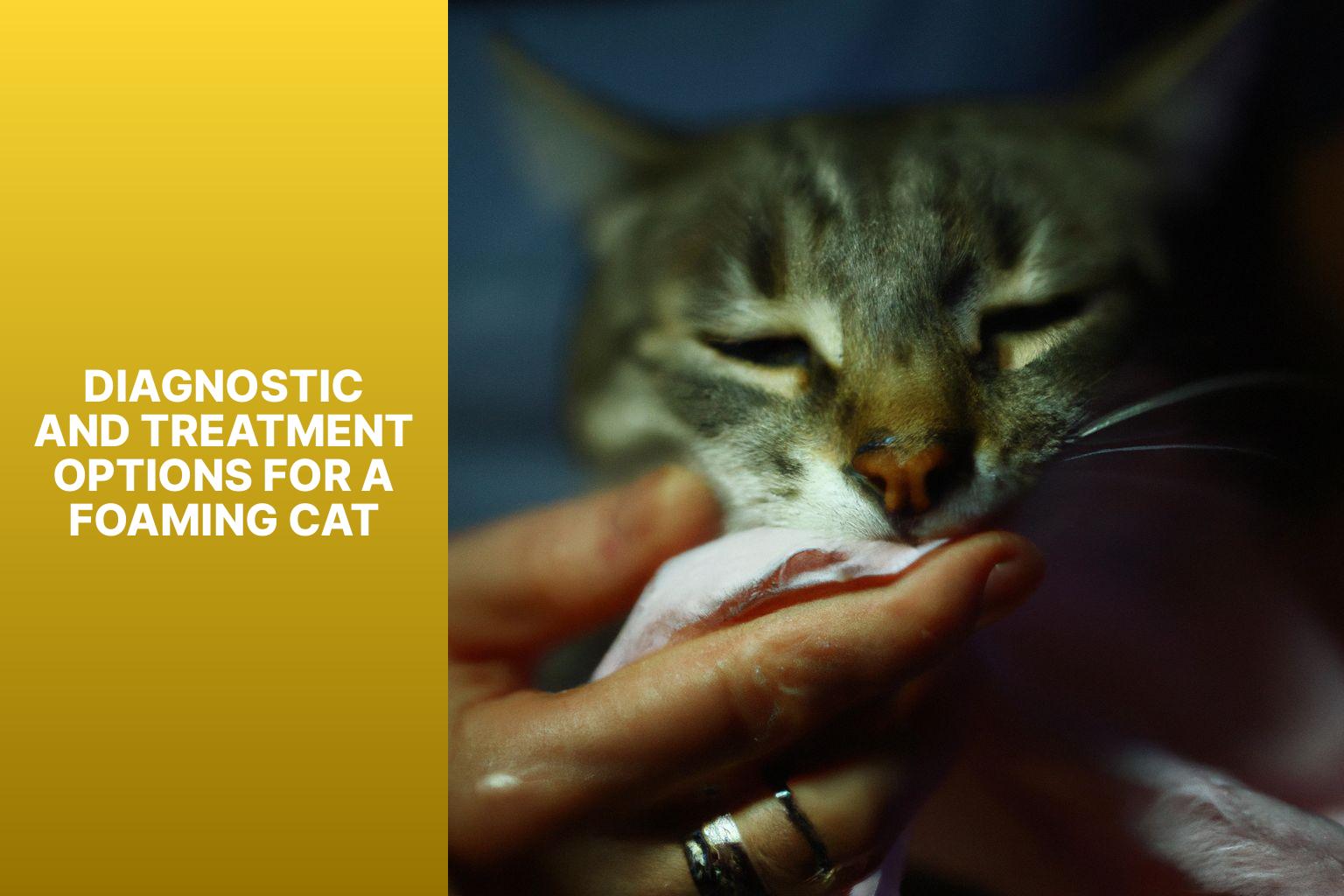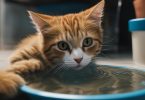Foaming at the mouth in cats can be a concerning and alarming sight for pet owners. It is essential to understand the potential causes and take appropriate actions when encountering such a situation. Several factors can contribute to a cat foaming at the mouth, including poisoning, oral irritation, rabies, allergic reactions, and respiratory issues.
When faced with a foaming cat, taking immediate steps is crucial to ensure the well-being of your pet. Maintaining calm and assessing the situation is the first step, followed by isolating the cat and ensuring its safety. Checking for any signs of injury or illness is important. Contacting a veterinarian is highly recommended to seek professional guidance and assistance in dealing with the situation. Collecting relevant information about the cat’s health history and symptoms will help the vet in making an accurate diagnosis.
It is vital to avoid certain actions when dealing with a foaming cat. Attempting to handle the cat without proper knowledge can be dangerous for both you and the cat. Administering medication without veterinary guidance should be avoided, as it can worsen the situation. Ignoring the symptom and delaying veterinary care is not recommended since the underlying cause needs to be identified and addressed promptly.
Once at the veterinarian’s office, a thorough examination and assessment will be conducted. This may involve laboratory tests and diagnostic procedures to determine the cause of the foaming. Once a diagnosis is made, an appropriate treatment plan and medications will be prescribed. Follow-up care and monitoring will be necessary to ensure the cat’s recovery.
By understanding the causes, taking immediate steps, avoiding certain actions, and seeking veterinary care, you can effectively address the issue of a foaming cat and ensure the well-being of your beloved pet.
Key takeaway:
- Poisoning, oral irritation or infection, rabies, allergic reaction, and respiratory issues can cause a cat to foam at the mouth.
- When a cat is foaming at the mouth, stay calm, isolate the cat, check for obvious signs of injury or illness, and contact a veterinarian.
- Avoid handling the cat without proper knowledge, administering medication without veterinary guidance, and ignoring the symptom and delaying veterinary care.
- Veterinary examination, laboratory tests, diagnostic procedures, appropriate treatment plan, and medications are essential for diagnosing and treating a foaming cat.
- Follow-up care and monitoring should be implemented to ensure the cat’s recovery.
What Could Cause a Cat to Foam at the Mouth?
Photo Credits: Www.Catcornerblog.Com by Brian Mitchell
Ever wondered why your furry friend is foaming at the mouth? In this section, we’ll dive into the possible causes that make a cat foam at the mouth. From poisoning and oral irritation to infections, rabies, allergic reactions, and respiratory issues, we’ll explore the various factors that could be behind this alarming symptom. Get ready to uncover the reasons and gain a deeper understanding of what could be affecting your cat’s health.
Poisoning
Poisoning is a serious concern if a cat is foaming at the mouth. Various substances can cause poisoning in cats, including household chemicals, medications, plants, and certain foods. Common signs of poisoning may include drooling, vomiting, diarrhea, seizures, and difficulty breathing. If you suspect your cat has been poisoned, seek immediate veterinary attention.
When dealing with a potentially poisoned cat, remember not to induce vomiting or give any medication without veterinary guidance. This could worsen the situation and cause further harm. Instead, a veterinarian will provide the proper care and treatment based on the specific type of poisoning and severity of symptoms.
To prevent poisoning, securely store all potentially toxic substances and keep them out of your cat’s reach. Be cautious about the plants in your home, as some can be toxic if ingested. Also, avoid feeding your cat harmful human foods like chocolate, onions, and grapes.
Fact: Certain household cleaning products, such as bleach and antifreeze, can be highly toxic to cats. Always read labels and use these products safely to protect your beloved feline friend from poisoning.
Oral Irritation or Infection
True story:
I once had a cat named Max who started foaming at the mouth. Concerned, I checked his mouth and saw a small piece of string stuck between his teeth. It was causing oral irritation or infection, leading to the foaming. I gently removed the string and cleaned his mouth. The symptoms of oral irritation or infection continued, so I took Max to the veterinarian. The vet confirmed that Max had an oral infection due to the irritation from the string. Max received appropriate treatment, including oral antibiotics and pain medication. With proper care and follow-up visits to the vet, Max’s condition improved, and he made a full recovery. This experience taught me the importance of seeking prompt veterinary attention when a cat foams at the mouth, as oral irritation or infection can have serious consequences if untreated.
Rabies
Rabies is a deadly virus that can cause a cat to foam at the mouth. It spreads most commonly through bites from infected animals like raccoons, bats, and foxes. Rabies attacks the central nervous system and can be fatal if not treated promptly.
If your cat may have rabies, it is crucial to seek veterinary attention immediately. Rabies can also be transmitted to humans, so taking necessary precautions is essential for both your cat’s well-being and your own safety.
When dealing with a potentially rabid cat, avoid handling it without proper knowledge and protection. Contact a veterinarian as soon as possible and follow their recommendations. They will assess the situation, perform tests if necessary, and provide treatment options.
Remember, rabies is a serious condition, and delaying veterinary care could have severe consequences. By seeking immediate attention, you ensure your cat receives proper care and treatment.
Fact: Rabies is one of the oldest known diseases, dating back thousands of years. The first written records of the disease date to ancient Mesopotamia around 2300 BC.
Allergic Reaction
Allergic Reaction
When a cat foams at the mouth, it may be due to an allergic reaction. Allergies can occur when a cat’s immune system overreacts to a substance like food, medication, or environmental allergens. Common symptoms of an allergic reaction in cats include foaming at the mouth, excessive itching, sneezing, coughing, and difficulty breathing.
If you suspect your cat has an allergic reaction, seek veterinary attention immediately. The veterinarian will diagnose the allergy and recommend the best course of action. They may suggest avoiding the allergen or prescribe medication to manage symptoms. In severe cases, emergency treatment may be needed to ensure the cat’s safety.
To prevent future allergic reactions, identify and avoid the trigger. This may involve dietary changes, removing potential allergens, or using hypoallergenic products. Regular communication with your veterinarian can help manage and prevent future allergic reactions in your cat.
Respiratory Issues
Respiratory issues are a common concern among cats and can cause them to foam at the mouth. It is important for cat parents to be aware of the signs and symptoms of respiratory issues, such as infections, allergies, or underlying conditions. If your cat is experiencing respiratory distress and showing signs like coughing, wheezing, or difficulty breathing, it is crucial to take immediate action.
Contacting a veterinarian and describing the symptoms is the first step in seeking guidance and appropriate care. It is important not to handle the cat or administer any medication without veterinary guidance when dealing with respiratory issues. Ignoring the symptoms and delaying veterinary care can lead to worsening of the condition and serious complications.
When visiting the veterinarian, they will thoroughly examine and assess your cat’s respiratory system. This may involve further tests or imaging to determine the underlying cause of the respiratory issues. The veterinarian will then create a treatment plan tailored to your cat’s needs, which may include prescribed medications, respiratory support, or other interventions.
After treatment, it is essential to provide proper care for your cat during their recovery. Following the veterinarian’s instructions and administering any prescribed medications are crucial. Creating a safe and comfortable environment for your cat is also important. Regular monitoring and follow-up appointments with the veterinarian will help track the progress and ensure your cat’s well-being.
Always remember, if your cat is experiencing respiratory issues and foaming at the mouth, prompt veterinary care is necessary for their health and well-being.
Immediate Steps to Take When a Cat is Foaming at the Mouth
Photo Credits: Www.Catcornerblog.Com by Charles Jackson
When a cat starts foaming at the mouth, it can be alarming and unsettling. But fear not! In this section, we will guide you through the immediate steps to take in such a situation. From staying calm and assessing the situation to ensuring the safety of both you and the cat, we’ll cover it all. We’ll also talk about checking for signs of injury or illness and the crucial step of contacting a veterinarian. Plus, we’ll share some tips on gathering relevant information for the vet. No need to panic – let’s handle this with care and expertise!
Stay Calm and Assess the Situation
When faced with a foaming cat, it is important to stay calm and assess the situation.
Take note of the cat’s behavior and surroundings, paying attention to any visible injuries or symptoms.
Always prioritize your own safety and the safety of others by keeping a safe distance if the cat seems agitated or aggressive.
In such cases, contacting a veterinarian promptly for guidance and advice is crucial.
When communicating with the veterinarian, make sure to provide clear information about the situation, as well as any observed symptoms or behavior.
While waiting for veterinary advice, gather relevant information about the cat, including its medical history and recent changes in environment.
Remember that it is best not to handle the cat without proper knowledge, as doing so may aggravate the situation.
It is important to avoid administering any medication without the guidance of a veterinarian.
By staying calm, assessing the situation, and seeking veterinary attention, you are taking the necessary steps to provide proper care and treatment for your foaming cat.
Isolate the Cat and Ensure Safety
When dealing with a foaming cat, it is important to prioritize the safety of both the cat and yourself. To ensure the safety of the cat, follow these steps:
1. Calmly and slowly approach the cat.
2. It is essential to have proper knowledge and experience when handling the cat to prevent aggression or injuries.
3. Find a safe and quiet area to isolate the cat, ensuring that no further harm comes to the cat.
4. Close all exits or openings to prevent the cat from escaping or causing additional harm.
5. If necessary, use protective gloves or equipment when handling the cat to reduce the risk of bites or scratches.
6. Make sure there are no hazards or dangerous objects nearby that could endanger the cat.
7. Keep other pets or children away to avoid conflicts or accidents.
8. From a safe distance, observe the cat for signs of distress or worsening symptoms.
9. Prioritize your own safety by avoiding close contact, which can prevent potential transmission of diseases.
10. Once the cat is safely isolated, contact a veterinarian for further guidance and appropriate medical attention.
Following these steps will effectively isolate the cat and ensure the safety of both the cat and the handler.
Check for Obvious Signs of Injury or Illness
When a cat is foaming at the mouth, it is important to check for obvious signs of injury or illness. To do this, follow these steps:
- Closely observe the cat for signs of distress, pain, or discomfort.
- Inspect the cat’s mouth for injuries, such as cuts, wounds, or foreign objects in the teeth or gums.
- Examine the cat’s face and head for swelling, redness, or abnormal discharge from the eyes, nose, or ears.
- Inspect the cat’s body for visible injuries like scratches, bites, or lumps.
- Gently palpate the cat’s body to check for tenderness, swelling, or abnormal lumps or bumps.
- Observe the cat’s breathing pattern. Difficulty breathing could indicate respiratory issues or underlying health problems.
- Monitor the cat for vomiting, diarrhea, lethargy, or unusual behavior.
Checking for these signs of injury or illness provides important information that can be shared with a veterinarian. Seeking veterinary attention is crucial to determine the cause of the foaming and ensure appropriate care and treatment for the cat.
Contact a Veterinarian
If your cat is foaming at the mouth, contact a veterinarian immediately. A veterinarian can assess the situation, provide guidance, and treat your cat’s well-being. Delaying veterinary care could worsen your cat’s condition.
To contact a veterinarian, call the nearest veterinary clinic or hospital in your area. Inform them about your cat’s symptoms and ask for their advice on what to do next. Provide clear and concise information to help the veterinarian assess the urgency of the situation.
When speaking with the veterinarian, be ready to provide details such as your cat’s age, breed, and any existing medical conditions or medications. This information will assist in determining the appropriate course of action and potential treatment options.
Remember, a veterinarian’s expertise is crucial in diagnosing and treating your cat. They have the knowledge and resources to provide proper care. Don’t hesitate to contact a veterinarian when your cat is foaming at the mouth.
Collect Relevant Information for the Vet
When a cat foams, it’s crucial to gather pertinent information for the vet. This can aid in determining the cause of the foaming and guiding treatment. Here are the steps to follow in order to collect relevant information for the vet:
1. Observe the cat’s behavior both before and during the foaming episode.
2. Take note of any changes in the cat’s eating, drinking, or elimination patterns.
3. Check if the cat has been exposed to any toxins or hazardous substances.
4. Record any recent modifications in the cat’s environment or the introduction of new products.
5. Make a note of any other symptoms or abnormalities the cat exhibits.
6. Provide the vet with information regarding the cat’s vaccination history.
7. Inform the vet about any prior medical conditions or treatments.
8. Share pertinent details about the cat’s diet and feeding schedule.
9. Describe the frequency and duration of the foaming episodes.
10. Mention any medications or supplements the cat may be taking.
By collecting this information, you can assist the vet in accurately diagnosing and determining the appropriate treatment for your foaming cat.
One evening, I noticed my cat foaming at the mouth and immediately contacted my vet. I provided details about the cat’s recent behavior, including changes in appetite and increased water consumption. I also mentioned the use of a new cleaning product in the house. Based on this information, the vet suspected oral irritation from the cleaning product. The vet recommended rinsing the cat’s mouth with water and closely monitoring for further symptoms. Thankfully, the foaming subsided after a few hours, and the vet’s advice ensured the well-being of my cat.
What Actions to Avoid When Dealing with a Foaming Cat
When it comes to dealing with a foaming cat, it’s crucial to know what actions to avoid. Handling the cat without proper knowledge, administering medication without veterinary guidance, or ignoring the symptom and delaying veterinary care can have serious consequences. In this section, we’ll uncover the potential pitfalls of these actions and shed light on the importance of making informed decisions to ensure the well-being of your furry companion.
Attempting to Handle the Cat Without Proper Knowledge
When dealing with a foaming cat, it’s crucial to avoid attempting to handle the cat without proper knowledge. This can exacerbate the cat’s condition or result in further injury.
To safely handle a foaming cat:
- Stay calm and observe the cat’s behavior from a secure distance.
- Refrain from trying to restrain or hold the cat without understanding cat behavior.
- Steer clear of forceful methods like grabbing or squeezing the cat, as this can distress and harm them.
- If necessary, seek guidance from a veterinarian or animal behaviorist on how to handle and restrain a cat.
- Remember that cats can become aggressive or defensive when frightened or in pain, so prioritize their well-being and safety.
Jenna, a cat owner, once discovered her cat foaming at the mouth after accidentally ingesting a household cleaning product. Without proper knowledge, she panicked and attempted to wash her cat with water, which only caused more distress. Realizing her mistake, she immediately contacted a veterinarian for guidance on handling the situation safely. Jenna learned the importance of seeking professional advice and not attempting to handle her cat without proper knowledge in emergencies.
Administering Medication Without Veterinary Guidance
Administering medication without veterinary guidance can be dangerous, as it can result in adverse reactions, incorrect dosages, or the use of inappropriate medications. It is important to understand the risks involved. Therefore, it is always advisable to consult a veterinarian before giving any medication to your cat. A veterinarian will assess your cat’s condition and provide appropriate treatment recommendations.
If medication is prescribed, it is crucial to follow the provided dosage instructions. This will ensure that your cat receives the correct amount of medication for effective treatment and avoids harmful side effects. Never give your cat human medication without consulting a veterinarian first. Medications intended for humans can be toxic to cats and cause severe harm.
If a veterinarian advises you to administer medication at home, it is essential to learn the proper administration technique. This includes making sure that the cat swallows the medication without spitting it out. Prioritizing your cat’s health and well-being is crucial, and trusting the expertise of a veterinarian is essential when it comes to administering medication to your furry friend. If you have any concerns or questions, do not hesitate to reach out to a veterinarian for professional advice.
Ignoring the Symptom and Delaying Veterinary Care
Ignoring the symptoms and delaying veterinary care can have serious consequences for a foaming cat. Foaming at the mouth is not normal for cats and often indicates an underlying health issue. By ignoring the symptoms and not seeking veterinary attention, you risk the cat’s well-being.
Delaying veterinary care can worsen the cat’s condition and lead to complications. Without proper diagnosis and treatment, the underlying cause of the foaming may go untreated, potentially resulting in further health problems or endangering the cat’s life.
Take immediate action when you notice a cat foaming at the mouth. Contact a veterinarian as soon as possible to schedule an appointment. The vet will assess the cat’s condition, perform tests, and recommend the appropriate course of action.
Ignoring the symptoms and delaying veterinary care is not recommended for a foaming cat. Your cat relies on you for proper care and attention, so seek veterinary care promptly to address the underlying cause of the foaming and provide necessary treatment.
Diagnostic and Treatment Options for a Foaming Cat
Photo Credits: Www.Catcornerblog.Com by Peter Rodriguez
When it comes to a foaming cat, understanding the diagnostic and treatment options is crucial. In this section, we’ll explore the veterinary examination and assessment process, the importance of laboratory tests and diagnostic procedures, and the development of an appropriate treatment plan and medication. These steps are essential to ensure the well-being and health of our furry feline friends. So, let’s dive into the world of diagnosing and treating a foaming cat!
Veterinary Examination and Assessment
A veterinary examination and assessment is crucial for a foaming cat to determine the underlying cause and provide appropriate treatment. Here are the key aspects of the veterinary examination and assessment:
- The veterinarian will thoroughly examine the cat for visible injuries or signs of illness.
- They will consider the cat’s medical history and any previous incidents of foaming at the mouth.
- Diagnostic tests like blood work, x-rays, or ultrasounds may be recommended to evaluate the cat’s condition further.
- The veterinarian will assess the cat’s behavior, including responsiveness, movement, and demeanor.
- Observing the cat’s vital signs, such as heart rate and respiration, can offer important health clues.
- Based on the veterinary examination and assessment, the veterinarian will make a diagnosis and discuss treatment options with the cat owner.
If your cat is foaming at the mouth, seek immediate veterinary attention. Avoid attempting to diagnose or treat the cat without professional guidance. Ignoring the symptom and delaying veterinary care can lead to complications. By following the recommended course of action, including a thorough veterinary examination and assessment, you can ensure your cat receives proper care.
Laboratory Tests and Diagnostic Procedures
Edited
Laboratory Tests and Diagnostic Procedures
- Laboratory tests: Veterinarians may conduct various laboratory tests to determine the cause of a cat foaming at the mouth. These tests include blood tests, urinalysis, and fecal examinations. They can help identify abnormalities in the cat’s blood, urine, or digestive system causing the foaming.
- Diagnostic procedures: X-rays or ultrasounds may be performed to further investigate the cat’s condition. X-rays identify abnormalities in the cat’s chest or abdomen causing the foaming. Ultrasounds provide a detailed view of specific organs or tissues.
- Bacterial or viral cultures: If an infection is suspected, veterinarians may take a sample from the cat’s mouth for bacterial or viral cultures. These cultures identify the specific bacteria or virus causing the infection.
- Biopsy: In some cases, a biopsy may be necessary to determine the cause of the foaming. Tissue is extracted from the affected area, such as the mouth or throat, and analyzed under a microscope.
- Endoscopy: A small camera is inserted into the cat’s throat to visually examine the esophagus, stomach, and upper respiratory tract. This procedure helps identify abnormalities or foreign objects causing the foaming.
True story: My own cat once started foaming at the mouth. Concerned for her well-being, I took her to the veterinarian. The vet conducted laboratory tests, including blood work and a bacterial culture. It was discovered that my cat had ingested a poisonous plant, causing the foaming. Thanks to the timely diagnostic procedures, the veterinarian provided appropriate treatment, and my cat made a full recovery. This story highlights the importance of laboratory tests and diagnostic procedures in identifying the cause of a cat foaming at the mouth and facilitating proper care.
Appropriate Treatment Plan and Medications
To address a foaming cat, a proper treatment plan and the right medications are crucial. Follow these steps:
1. Consult a veterinarian: Seek veterinary attention for a diagnosis and treatment approach. The vet will evaluate the cat’s overall health and look for underlying causes.
2. Follow the recommended course of action: Once the vet assesses the cat’s condition, they will develop a tailored treatment plan. This may involve medications for infections, allergies, or respiratory issues contributing to the foaming.
3. Administer medications as prescribed: Follow the vet’s instructions on medication type, dosage, and frequency. Giving medication without veterinary guidance can harm the cat’s health.
4. Monitor progress and make adjustments: Regularly observe the cat’s response to the treatment plan and report any changes or concerns to the veterinarian. They may recommend medication adjustments or additional tests if needed.
Remember, professional guidance is essential for proper care of a foaming cat. Never attempt to diagnose or treat the cat on your own. Reach out to a veterinarian and follow their expertise for the best outcome.
(
Follow-up Care and Monitoring
Regular follow-up care and monitoring is essential for the cat’s full recovery and to prevent relapses or complications. Therefore, it is important to observe the cat’s behavior closely for any symptoms or complications and monitor their appetite and drinking habits to ensure they return to normal. Regularly checking the cat’s mouth for inflammation or infection is recommended. It is also crucial to continue any prescribed medications or treatments as directed by the veterinarian.
Some Facts About What to Do When Cat Is Foaming at the Mouth:
- ✅ Foaming at the mouth in cats can be caused by various reasons. (Source: Our Team)
- ✅ One possible reason for cat foaming at the mouth is nausea. (Source: Our Team)
- ✅ Foaming at the mouth in cats can also be caused by anxiety and fear. (Source: Our Team)
- ✅ Dental problems, such as infections or diseases, can cause foaming from the mouth in cats. (Source: Our Team)
- ✅ Excessive drooling and foaming in cats can be a symptom of viral infections. (Source: Our Team)








